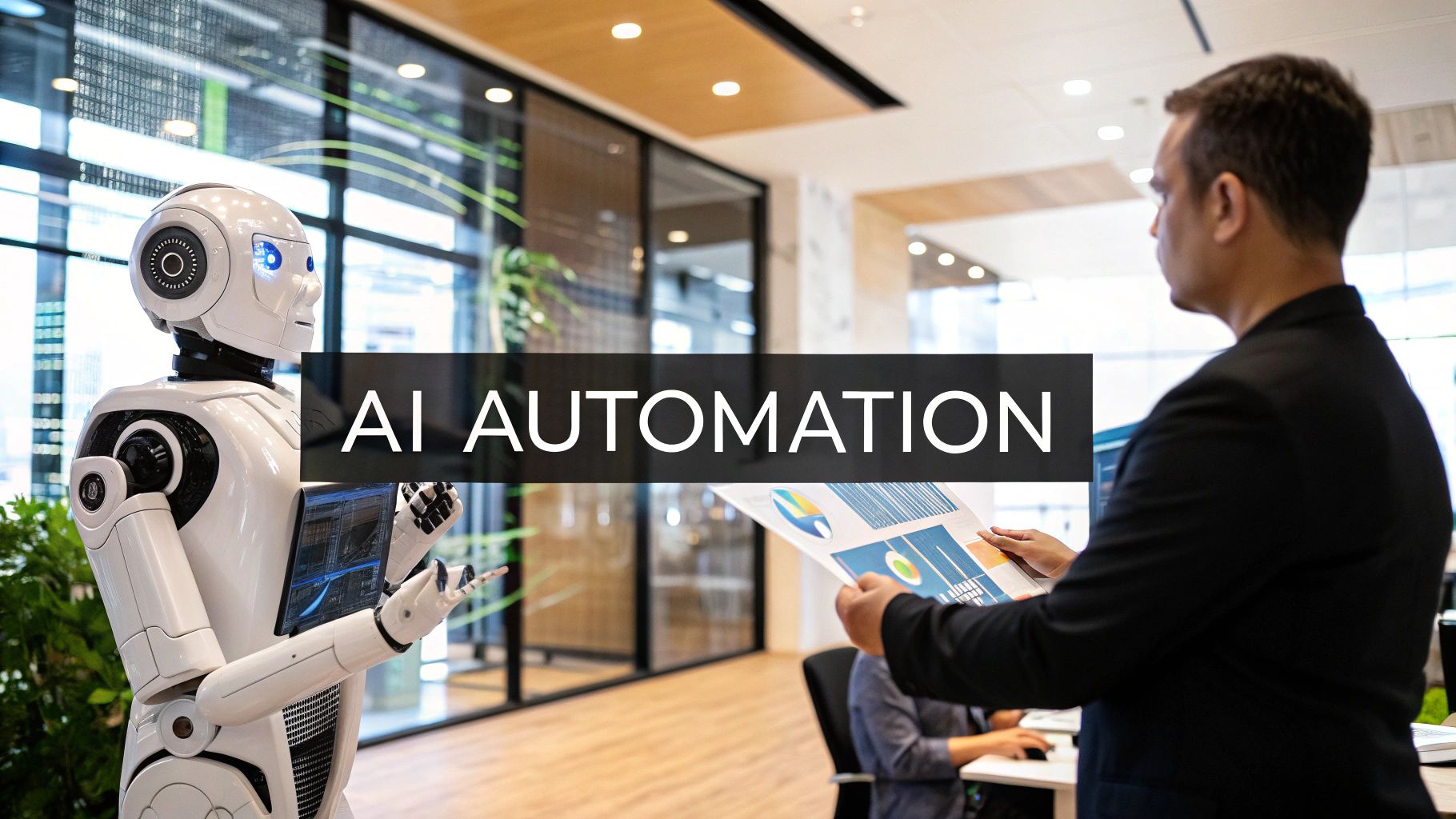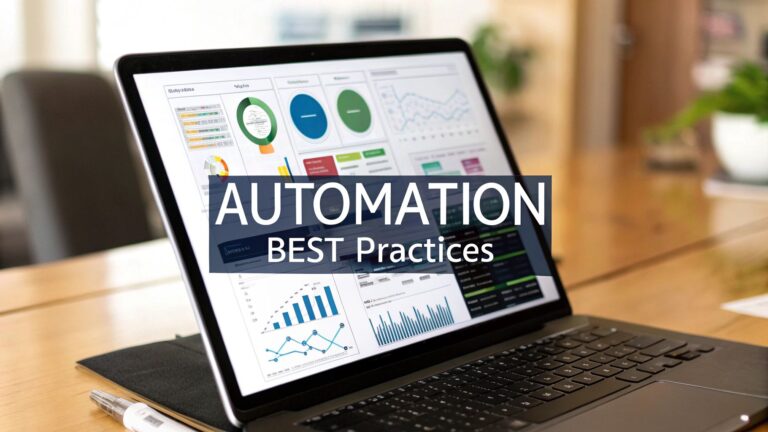Unlocking Growth with AI Automation for Business
When people hear "AI automation," their minds often jump to sci-fi movies. But in the real world of business, it’s much more practical. It’s simply about using smart software to take over the repetitive, data-heavy tasks that used to eat up your team's valuable time.
Think of it less like a robot takeover and more like hiring a team of incredibly efficient digital assistants. These assistants work around the clock, never get tired, and handle the grunt work, freeing up your people to focus on what they do best: thinking strategically, getting creative, and building real relationships.
What AI Automation Actually Looks Like in a Business
I like to use a self-driving car analogy. On a long, straight highway, the car's AI can handle the steering, speed, and lane changes—all the boring, repetitive parts of the drive. This lets the human driver focus on the bigger picture, like planning the route, navigating tricky city streets at the end, or just enjoying the view. In business, AI automation is what handles the "highway driving" of your operations.
This could be anything from data entry and processing invoices to answering the same customer questions over and over again. Now, you might be thinking, "Isn't that just regular automation?" Not quite.
While traditional automation is great, it's a bit rigid. It follows simple, pre-programmed rules. AI automation, on the other hand, brings a layer of intelligence to the table. It learns from new data, makes smart decisions, and adapts on the fly. That flexibility is what makes it so powerful.
Where Automation Gets Its Brains
The real breakthrough happens when you pair the raw power of automation with the intelligence of AI. Automation is the engine that gets things done, but AI is the brain that guides it. This partnership elevates you from just completing tasks to truly optimizing entire processes.
Here's the difference in a nutshell:
- Traditional Automation: This is all about "if-then" logic. "If an email has the word 'invoice' in the subject, then forward it to accounting." It's helpful, but it's limited.
- AI-Powered Automation: This system understands context. It can "read" an email, recognize it's a high-priority invoice from a top-tier supplier, pull out the due date and amount, and then enter that information directly into your accounting software—all without a person lifting a finger.
The goal is simple: let technology handle the predictable, rule-based work. This frees your team to pour their energy into complex problem-solving, nurturing customer relationships, and driving innovation—the very things that a machine can't replicate.
To get a feel for how these ideas translate into real-world results, especially for growing companies, it’s worth exploring the fundamentals of marketing automation for small businesses. It's a fantastic starting point for seeing how this technology creates tangible value.
Core Benefits of AI Automation at a Glance
So, what are the tangible rewards of bringing AI automation into your workflow? The advantages show up across the entire organization, from the back office to the front lines.
The table below breaks down the primary benefits you can expect to see.
| Benefit Area | Description | Example Application |
|---|---|---|
| Increased Efficiency | Handles tasks faster and more consistently than humans, operating 24/7 without breaks or fatigue. | An AI chatbot instantly resolves 70% of routine customer support queries, day or night. |
| Reduced Costs | Lowers operational expenses by minimizing manual labor hours and reducing errors that require costly fixes. | Automating invoice processing cuts the time spent by the finance team on data entry by 80%. |
| Enhanced Decision-Making | Analyzes vast datasets to uncover insights and patterns, enabling more informed strategic choices. | An AI system analyzes sales data to predict future demand, optimizing inventory levels. |
| Improved Accuracy | Eliminates human error in repetitive tasks like data entry, ensuring greater consistency and reliability. | AI software accurately extracts customer information from forms, avoiding typos and mistakes. |
Ultimately, these benefits don't just add up to minor improvements. They compound over time, giving your business a serious competitive edge by making it faster, smarter, and more resilient.
Understanding the Technologies That Power Automation

To really get what AI automation for business can do, it helps to peek under the hood at the technologies making it all happen. You don't need to be a data scientist, but knowing the "what" and "why" behind these tools is key to spotting opportunities in your own company.
First off, let’s clear something up. There are two main flavors of automation. The traditional, rule-based kind is like a basic calculator. It’s perfect for following strict, pre-set commands—"if this happens, then do that." It's incredibly reliable, but it can’t deviate from the script.
Intelligent AI automation, on the other hand, is much more like a seasoned expert on your team. It doesn't just stick to the rules; it analyzes messy data, spots trends, learns from new information, and actually offers up insights. This ability to adapt and "think" is what separates simple task-doing from genuine process transformation.
The Key Players: Machine Learning, NLP, and RPA
Think of these technologies as a high-performing team, where each member brings a unique talent to the table. When they work in concert, they can automate some seriously complex business functions. Let’s meet the main players.
1. Machine Learning (ML)
This is the "brain" of the operation. Machine Learning gives systems the power to learn from data without someone having to write explicit code for every single scenario. It’s the magic behind Netflix knowing what you want to watch next or your bank flagging a weird transaction.
- How it works: You start by feeding an ML model a ton of historical data, like thousands of your past sales records. The model chews on this data and learns what patterns lead to a successful deal.
- Business application: After learning, it can start predicting which new leads are most likely to convert with over 90% accuracy in some cases. This lets your sales team stop guessing and focus their energy where it will have the biggest impact. The best part? It keeps getting smarter with more data.
2. Natural Language Processing (NLP)
NLP is the translator, the essential bridge between human language and computer logic. It’s what gives software the ability to read, understand, and even generate human text and speech.
Imagine a customer fires off an angry email about a delayed delivery. An NLP-powered system can instantly pick up on the negative tone, identify the root problem ("late shipment"), and automatically bump it to the top of the queue for your support team.
This is why modern chatbots feel less robotic and how some tools can summarize a 20-page report or a thousand customer reviews in a matter of seconds.
3. Robotic Process Automation (RPA)
If ML is the brain, think of RPA as the tireless "digital hands." RPA uses software "bots" to mimic the repetitive, structured tasks a person would do on a computer. These bots can log into apps, copy and paste data, fill in forms, and move files around.
Essentially, an RPA bot is like a digital employee who never gets tired or needs a coffee break. For example, it can take invoice details pulled out by an NLP tool and then enter that same information into your ERP, your CRM, and your accounting software—perfectly, every single time.
When you bring these three technologies together, the potential for AI automation for business really explodes. ML provides the intelligence, NLP handles the communication, and RPA executes the physical tasks. Together, they create a fluid workflow that can manage a process from start to finish, turning mind-numbing manual work into a real competitive edge.
The Real-World Impact on Your Bottom Line

It’s one thing to talk about the tech, but the question that really matters is: what does AI automation for business actually do for your bottom line? Let's move past the theory and look at the tangible, measurable returns that justify the investment. This isn't just about making things faster; it's about fundamentally changing how work gets done to drive real growth and profitability.
Think about a mid-sized B2B company drowning in paperwork. Every month, their finance team would lose days to manually entering invoice data, matching purchase orders, and chasing down approvals. It was more than just slow—it was a recipe for costly mistakes and delayed payments.
By bringing in an AI automation tool, they completely flipped the script on that workflow. The AI could instantly "read" invoices, pull out the key information, and check it against company records in seconds. What used to take the better part of a week now gets done in minutes. Suddenly, the finance team was free to focus on strategic financial planning instead of mind-numbing data entry.
Boosting Revenue and Customer Loyalty
The financial upside of AI automation goes way beyond just trimming back-office costs. It’s a powerful engine for growth, directly influencing how you make money and keep your customers coming back.
Picture an e-commerce business using AI to sharpen its marketing. Instead of blasting the same generic email to everyone, the system analyzes each customer's browsing history, past purchases, and what they’re looking at right now. Based on that, it automatically sends them personalized product recommendations they’ll genuinely be interested in.
This kind of personal touch hits several key business goals at once:
- Higher Conversion Rates: When you show customers exactly what they're looking for, they're far more likely to click "buy."
- Stronger Customer Loyalty: Customers who feel understood are more likely to return, transforming one-time buyers into genuine fans.
- Increased Average Order Value: Smart AI can suggest complementary items, effectively upselling and cross-selling to increase the value of each purchase.
It's a perfect example of how automation can actively generate new revenue, not just save money on the back end.
Accelerating Decisions and Time to Market
In today's world, speed is everything. AI-powered analytics give leaders the ability to make smarter decisions faster than ever before. You no longer have to wait weeks for someone to manually crunch the numbers and build a report; AI can process enormous datasets in real time to find the hidden gems.
This means you can spot a new market trend, identify a potential snag in your supply chain, or pick up on a shift in customer mood long before your competitors even know what's happening. Acting on those insights helps you bring new products and services to market quicker and with more confidence.
And these aren't just hypotheticals. The data shows that companies embracing automation see an average 22% reduction in operating costs. Better yet, tools like Robotic Process Automation (RPA) can deliver a return on investment (ROI) of 30% to 200% in the very first year.
The Snowball Effect on ROI
The true return on investment from AI automation isn't from one single change. It’s the cumulative, snowball effect it has across your entire organization. When your finance team is more strategic, your marketing is more personal, and your decisions are faster and better informed, the whole business just runs on a different level.
This creates a powerful, positive cycle. Greater efficiency frees up resources for innovation. Better customer experiences lead to higher revenue, which you can then reinvest into even more advanced automation. When you look at it through the lens of these real-world business scenarios, the value becomes crystal clear. It's an investment that doesn't just boost productivity—it directly fuels sustainable growth. For more ideas, check out our guide on how to increase team productivity with smart strategies.
AI Automation Use Cases You Can Implement Now

This is where the rubber meets the road. It’s one thing to talk about what AI automation for business is, but seeing how it solves real-world problems is where the value truly clicks. Let's walk through a few departments to see where AI can make an immediate, tangible difference. The goal here is to help you spot the low-hanging fruit in your own organization.
Don't mistake this for some futuristic trend, either. The adoption rates are staggering. Right now, around 78% of companies around the world are already using AI in at least one part of their business. In fact, most are using it in an average of three different areas, which shows just how flexible this technology has become.
This isn't just a big-business game. AI automation is a practical tool that 89% of small businesses are actively using to get routine work off their plates and sharpen their competitive edge.
Supercharge Your Marketing and Sales Engine
In marketing and sales, the daily grind can easily swallow up your team's most valuable time—the time they should be spending building relationships and actually selling. AI automation is the perfect antidote to this.
Take email lists. Your team might spend hours trying to manually group contacts, often relying on little more than a hunch. An AI tool, on the other hand, can instantly analyze customer data—what they've bought, which pages they’ve clicked, how they engage with emails—and segment audiences with pinpoint accuracy. This means you can finally run deeply personalized campaigns that people actually respond to, pushing your conversion rates way up.
For your sales reps, the biggest headaches are usually lead qualification and keeping the CRM from becoming a mess.
- The Problem: Sales reps waste a huge chunk of their day sifting through new leads, trying to guess who's genuinely interested.
- The AI Fix: An AI system can score every lead automatically based on their behavior and profile, instantly flagging the ones who are ready for a conversation.
- The Result: Your team stops chasing dead ends and focuses their energy on talking to prospects who are much more likely to buy. The AI can even handle the mind-numbing data entry, keeping your CRM spotless without anyone lifting a finger.
Think of AI as the ultimate sales assistant. It makes sure every lead is properly vetted and every interaction is recorded, freeing up your team to do the one thing software can't: build real human connections.
Revolutionize Your Customer Support
Customer service is another area practically begging for AI automation. So many support tickets are the same simple, repetitive questions that tie up your best agents. This is where intelligent chatbots and automated workflows come in, forming a key part of optimizing your support strategy.
An AI-powered chatbot can provide instant answers 24/7 to common questions like "Where is my order?" or "How do I reset my password?" This immediate help keeps customers happy and filters out all the easy-to-solve queries from your agents' queue.
But what happens when an issue is truly complex or requires a human touch? A smart AI knows its limits. It can seamlessly escalate the conversation to the right person, handing them the full chat history and customer profile. This means your agents spend their days solving meaningful problems instead of sounding like a broken record.
Streamline Your Human Resources Processes
Even HR, a department that’s all about people, can get a massive efficiency boost from AI automation for business. Just look at the hiring process, which is often bogged down by a mountain of administrative tasks.
Think about the flood of applications that a single job post can bring in.
- The Problem: HR managers burn countless hours manually sifting through résumés, most of which aren't even a close match.
- The AI Fix: An AI tool can scan thousands of résumés in minutes, instantly identifying the candidates whose skills and experience line up with what you're looking for.
- The Result: Your hiring team gets a pre-vetted shortlist of top-tier candidates. This drastically cuts down the time-to-hire and lets them focus on conducting high-quality interviews.
From there, AI can keep the ball rolling by automating the onboarding process—sending out paperwork, scheduling orientation meetings, and answering common new-hire questions to ensure every person joining your team has a smooth, welcoming start.
How to Build Your AI Automation Strategy
A great AI automation initiative starts with a smart plan, not just shiny new tech. I've seen too many companies jump in headfirst without a clear roadmap, and it's a common misstep. The reality is that around 70% of digital transformation and automation projects fail to hit their goals, which really highlights the risks involved. You can find more details about why this happens and how to avoid it in various industry reports on automation statistics.
To make sure you don't become part of that statistic, you need a deliberate strategy. This isn't about trying to overhaul your entire business overnight. It's about taking measured, logical steps that build momentum, prove value, and get your team excited for the journey.
Think of it as a continuous loop: you spot opportunities, implement the right tools, and then watch the results to keep improving.

The big takeaway here? Successful AI automation isn't a "one-and-done" project. It's an ongoing cycle of refinement that's fueled by real-world performance data.
Find Your Starting Point
First things first, you need to figure out where to begin. Your goal is to find tasks that are relatively easy to automate but will give you a high-impact return. Think about the biggest bottlenecks and nagging pain points in your team's day-to-day work.
You're looking for processes that are:
- Repetitive and Rule-Based: Tasks your team does the exact same way every single time, like routine data entry or pulling standard reports.
- High-Volume and Time-Consuming: Activities that gobble up a ton of employee hours each week, such as processing invoices or sorting through customer support tickets.
- Prone to Human Error: Work where tiny mistakes can snowball into big problems, like manually copying customer data between different software systems.
When you start by solving a clear business problem instead of chasing a tech solution, you guarantee that your first project delivers real, measurable value. A quick win is the best way to build confidence and get buy-in for whatever comes next.
Pick the Right Tools for the Job
Once you've zeroed in on a process, you have to decide whether to build a custom solution or buy an existing tool. For most businesses, especially if you're just starting out, buying a ready-made SaaS platform is the most practical choice.
The modern AI world is full of powerful no-code and low-code platforms. These tools are game-changers because they let non-technical team members build and launch sophisticated automation workflows with intuitive drag-and-drop interfaces. You no longer need a dedicated team of data scientists for every project.
When you're looking at different tools, think about how easy they are to use, how well they integrate with your current software, and whether they can grow with you. Does the tool solve your specific problem effectively? For example, a deep dive into AI marketing automation can point you to platforms built specifically for personalizing campaigns—which might be the perfect fit for your marketing team.
Prepare Your People and Your Data
Technology is only one piece of the puzzle. Your people and your data are just as critical. For AI to work its magic, it needs clean, well-structured data to learn from. Before you roll out any new tool, take the time to audit your data sources and make sure everything is accurate and consistent.
Just as important is managing the human side of this change. It's natural for your team to feel a bit anxious about automation. Be transparent and communicate your vision clearly: the goal is to augment their abilities, not replace their roles. Frame AI as a partner that will handle the tedious work, freeing them up for more creative and strategic tasks. Investing in training is essential for a smooth transition. For a more in-depth look, you might find this guide on leveraging AI automation for business success helpful.
Run a Pilot Project and Scale Your Success
Whatever you do, don't try to boil the ocean. The best way to implement AI automation for business is to start with a small, contained pilot project. Pick one of those high-impact, low-effort tasks you found earlier and apply your chosen tool to that specific workflow.
This approach lets you do three crucial things:
- Test the Technology: You can work out any kinks in a low-risk setting.
- Measure the ROI: You'll gather hard data on time saved, errors reduced, or costs cut.
- Gather Feedback: You can learn directly from the employees who are using the new system.
Once your pilot project succeeds, you'll have a powerful case study to share with the rest of the company. Use that success story to build excitement and momentum. From there, you can start scaling your efforts, methodically applying what works to other teams and processes across the organization.
The Future of Business Automation
To get ahead and stay there, you have to understand where AI automation for business is heading. The changes coming down the pike aren't just minor tweaks; we're talking about a fundamental rethinking of how companies work, create, and compete. We're moving away from automating single, disconnected tasks and toward a future of deeply interconnected and intelligent systems.
One of the biggest drivers of this change is a concept called hyperautomation. The best way to think about it is as AI automation on steroids. It’s a practical, business-first strategy where companies intelligently combine multiple technologies—like machine learning, RPA, and process mining—to automate entire, complex processes from start to finish. It’s the difference between automating simple invoice data entry and automating the entire procure-to-pay journey.
The Rise of Autonomous Systems
We're also on the cusp of another massive shift: the emergence of autonomous AI agents. These aren't just bots following a script. They're sophisticated digital workers that can manage entire workflows with very little human input. Picture an AI agent in charge of lead generation that can find prospects, write personalized emails, book meetings, and keep the CRM updated all on its own.
And then there's generative AI, which has completely changed the game. It's already proven its mettle in creating everything from marketing copy and software code to product designs. This tech is quickly becoming a go-to tool for businesses, almost like a creative partner that can drastically speed up innovation. These breakthroughs point to new business models where humans and AI working together is the norm.
The future isn't about replacing people. It's about creating a powerful synergy where AI handles the heavy lifting of data analysis and repetitive tasks, freeing up human talent to focus on what they do best: strategy, creativity, and high-level decisions.
This future is materializing faster than you might think, thanks to a flood of investment into the field. All signs point to major growth, with the AI market projected to rocket past $240 billion by 2025. For some industries, the impact will be staggering; IT and telecom alone could see $4.7 trillion in value unlocked by AI by 2035.
Having a long-term automation plan is no longer a "nice-to-have." The businesses that will win in the coming years are the ones that view AI not just as a cost-cutter but as a strategic partner for building a smarter, more nimble, and resilient company. If you're ready to start, our guide on 10 proven strategies to boost business efficiency with automation is a great place to begin.
Got Questions? We've Got Answers
It's completely normal to have questions when you're thinking about bringing AI automation into your business. It’s a big step, after all. Leaders want to know what they’re really investing in, what the impact will be, and how to even begin.
Let's clear up some of the most common concerns so you can move forward with a solid plan.
How Much Does AI Automation Cost for a Small Business?
The honest answer? It really depends on what you want to achieve. The costs can vary quite a bit.
You could get started with simple, off-the-shelf software tools for things like scheduling social media posts for as little as $50 to $200 per month. On the other hand, more sophisticated platforms—like a CRM with AI built-in or a full-on Robotic Process Automation (RPA) tool—might run from a few hundred to several thousand dollars a month.
The trick is to not go all-in at once. Start small. Pick a single, well-defined project to prove the value and see a return on your investment before you even think about scaling up.
Will AI Automation Replace Our Employees?
This is probably the biggest myth out there. The goal of AI automation is to make your team better, not replace it. Think of it as giving your employees a powerful new assistant.
AI is fantastic at handling the repetitive, mind-numbing tasks that people generally don't enjoy anyway.
By taking over that kind of grunt work, automation frees your people to focus on what they do best: creative problem-solving, thinking strategically, and building real relationships with your customers. Many businesses find that AI actually helps them upskill their teams, creating more interesting and valuable roles.
What Is the Easiest Way to Get Started?
The best first move is to find one specific process that's repetitive, happens a lot, and is a clear pain point for your team. Resist the temptation to automate an entire department right out of the gate. That's a recipe for headaches.
Instead, look for the low-hanging fruit. Pick a task where you can easily see and measure the improvement, like time saved or errors eliminated.
Good starting points often include:
- Automatically sending customer support tickets to the right person.
- Processing invoices and purchase orders from suppliers.
- Generating those standard weekly or monthly performance reports.
Nailing a small pilot project is the single most effective way to get everyone on board for future AI automation for business initiatives.
Ready to stop wasting time on manual tasks and start scaling your business? MakeAutomation specializes in building the AI and automation frameworks that B2B and SaaS companies need to accelerate growth. We provide hands-on support to implement streamlined workflows, from lead generation to project management, so you can reclaim your time and boost your ROI. Learn how MakeAutomation can build your AI-powered future today.







